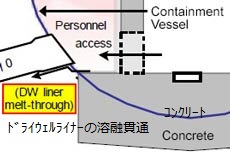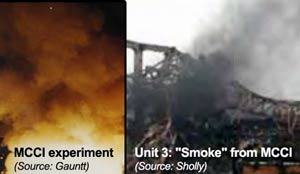http://www.asyura2.com/15/genpatu43/msg/134.html
| Tweet |
US Gov’t: Melted fuel most likely burned through containment at Fukushima reactors; We’re concerned about failures underground… “Where did it leak out? How did it leak out? We don’t know” — Expert: Corium may have flowed into reactor buildings, burned through floor (PHOTOS & AUDIO)
米国政府:溶融燃料は福島の原子炉格納容器を燃焼貫通した可能性が最も高い;我々は地下の障害を懸念しています... 「それはどこに漏れ出したのですか?それはどのように外部に漏れたのですか?我々は分かりません」 - 専門家:炉心溶融物は床部を燃焼貫通し、原子炉建屋に流入している可能性があります(写真・音声)
Published: May 28th, 2015 at 2:30 pm ET By ENENews
公開:2015年5月28日、午後2時30分 ET ENENewsによる
Brian Sheron, Office Director of Nuclear Regulatory Commission’s Office of Nuclear Regulatory Research, NRC’s 2013 Regulatory Information Conference (emphasis added): Aqueous release occurred during Fukushima accident… Current models do not address aqueous release pathways… [NRC's Office of Nuclear Regulatory Research] is starting a program to assess: Containment failure modes that could lead to aqueous releases; Source term modeling for aqueous pathways; Transport of contaminated water and its radiological consequences…
ブライアン・シャーロン、原子力規制研究の原子力規制委員会事務局ディレクター、原子力規制委員会の2013年規制情報会議(強調は記者):水の放出が福島の事故の際に発生しました...現在のモデルは水放出経路に対応していません... [原子力規制研究の原子力規制委員会事務局は]評価するプログラムを初めています。水の放出につながる可能性がある格納容器破損の形態。水の経路のソースターム(被曝(被爆)解析に必要な条件や要素) のモデル化、汚染水の輸送とその放射能の影響...

Sheron, Part I (6:15 in): “Another area that we’re looking at — it’s not really part of the ‘Post-Fukushima Lessons Learned’ — it’s aqueous pathways. One of the things we saw — and it was because most likely perhaps containment failure and liner melt-through — that there was contaminated water that was released to the environment into the ground. And the question is, how does that water behave once it’s released? How does it find its way to other waterways? What kind of doses might be expected from that? We’re just starting right now to do some work in that area.”
シャーロン、パートI(6分15秒の所で):「我々が見ている別の領域 - それは本当に「福島後に学習された教訓」の一部ではありません - それは水の経路です。私たちが見たことの一つです – そしておそらく最も可能性の高い格納容器破損とライナーのメルトスルーがあったからです – 大地の環境に放出された汚染水がありました。そして問題は、一度それが放出されると、水はどのように振る舞うのですか?どのようにして他の水路への経路を見つけるのですか?どんな種類の(放射)線量がそのことから予想されますか?我々は丁度そのエリアのいくつかの作業を行う事を今すぐ始めています。」
Sheron, Part II (11:45 in): “There was actually aqueous releases at Fukushima… The question is: Where did it leak out? How did it leak out? We don’t know yet. Speculation is… the core melt probably went down into the drywell, spread, and perhaps burned through the liner, which will provide a release path… The question now is: if there are aqueous release paths during a severe accident, what are the consequences? What we’re planning on looking at, at least — we haven’t started — is to first look at containment failure modes: Did we miss anything?
シャーロン、パートII(11分45秒の所で)「福島で水の放出が実際にありました...質問です:それはどこに漏れ出したのですか?それはどのように外部に漏れたのか?我々はまだ知りません。憶測は...炉心はおそらくドライウェルに落ちて、広がり、そしておそらくライナーを燃焼貫通した、そのことが放出経路を供給するでしょう...質問は以下のようになります:もしシビアアクシデント時に水の放出経路が存在する場合には、結果は何ですか?我々が少なくとも、見ようと計画している事は – 我々は始めていないが - 格納容器破損の状況をまず目にすることです:我々は何か見逃しませんでしたか?
Are there containment failure modes — that could occur below grade, you might say [Below grade: The portion of a building that is below ground level] — where water could leak out? The source term modeling for the aqueous pathways. Then the transport of that contaminated water, and the radiological consequences. How does it get into surface water? Does it stay in ground water? And what are the radiological doses… downstream? The expectation is, we’ll get a better feel for what the safety concern is with that, and whether any further actions are needed.”
格納容器破損障害の状況があります – それは地表下に発生する可能性がある、とあなた方は言うかもしれません[地表下:グラウンドレベルより低い建物部分] - どこに水が漏れ出す可能性がありますか?水の経路のソースターム(被曝(被爆)解析に必要な条件や要素)のモデル。それから、その汚染水の輸送、及び放射能の影響。それはどのようにして地表水に入るのでしょうか?それは地下水に滞在しますか?そして下流の放射線量は何ですか?...予想は、何の安全性の問題がそれに伴うのか、そしてそれ以上のアクションが必要かどうか、我々は良い感触を得るだろう、ということです。」
Randall Gauntt, Manager of Sandia National Laboratories’ Severe Accident Analysis Dept., NRC’s 2013 Regulatory Information Conference (15:00 in): “You can see core materials dropping down… about 90 tons of core material to the cavity region. When that material hits the cavity, core concrete interaction starts up. This is a picture from an experiment where we’re looking at core-concrete interaction. To give you an idea, once it hits the floor, more bad stuff happens — here you see what core-concrete interaction looks like.”
ランドール・ゴーン、サンディア国立研究所のマネージャー、シビアアクシデント解析部、2013年原子力規制委員会・規制情報会議(15分の所で):「あなた方は、炉心物が落下するのが分かります...空洞域に炉心物が約90トン。その物が空洞に当たると、炉心コンクリート相互作用が起こります。これは、我々が炉心コンクリートの相互作用を見ている実験からの画像です。あなたのアイデアを与えるために、それが一度床に当たると、もっと悪い事が発生します - ここで炉心コンクリート相互作用がどのように見えるか分かります。」

Steven C. Sholly, Senior Scientist, Institute of Safety and Risk Sciences: Fukushima Accident Progression — Core debris… attacks the concrete on the drywell floor [and] can contact the drywell shell… in the absence of water on the drywell floor, melt-through of the drywell shell is likely… [I]t is possible for core debris… to flow into the vent pipes, melt through them, and deposit on the lowest level of the reactor building… “Molten Corium/Concrete Interaction” (MCCI) can take place in both the drywell and the reactor building.
スティーブン・C・シェリー、主任研究員、安全性とリスク科学研究所:福島事故の進行 – 炉心の破片(デブリ)が...ドライウェル床のコンクリートを攻撃する[そして]、ドライウェル床に水が存在せず...ドライウェルシェルに接触し得ます、ドライウェルシェル溶融貫通の可能性が高いです... [そ]れは、炉心の破片にとって可能です...ベント管に流入し、それらを通して溶融、そして原子炉建屋の最低レベルに堆積する... 「溶融炉心燃料/コンクリート相互作用」(MCCI)がドライウェルと原子炉建屋の両方で起こり得ます。
See also: US gov’t analysis says Fukushima is more serious than ‘China Syndrome’ — Destroyed reactors suffered drywell liner failure, the worst type of containment failure
参照:米国政府の分析は述べています、福島は「チャイナ·シンドローム」よりも深刻です - 破壊された原子炉は、ドライウェルライナー障害を負いました、格納容器破損の最悪のタイプ
投稿コメント全ログ コメント即時配信 スレ建て依頼 削除コメント確認方法
▲上へ ★阿修羅♪ > 原発・フッ素43掲示板 次へ 前へ
 スパムメールの中から見つけ出すためにメールのタイトルには必ず「阿修羅さんへ」と記述してください。
スパムメールの中から見つけ出すためにメールのタイトルには必ず「阿修羅さんへ」と記述してください。すべてのページの引用、転載、リンクを許可します。確認メールは不要です。引用元リンクを表示してください。